shoredate: Shoreline dating Stone Age sites on the Norwegian Skagerrak coast
Isak Roalkvam
Source:vignettes/shoredate.Rmd
shoredate.RmdIntroduction
The concept of dating sites based on their present-day elevation with reference to past shoreline displacement has been an important tool for archaeologists in northern Scandinavia since the early 1900s (e.g. Brøgger 1905). This is based on the observation that Stone Age sites in the region tend to have been located close to the contemporaneous shoreline when they were in use. Furthermore, following the retreat of the Fennoscandian Ice Sheet, the isostatic uplift has been so severe that despite corresponding eustatic sea-level rise, the relative sea-level has been falling throughout prehistory in large parts of this region. Within any given area where this is the case, the general pattern is thus that older sites will be located at higher altitudes than younger sites.
This vignette describes the R package shoredate which provides tools for shoreline dating Stone Age sites located on the Norwegian Skagerrak coast using the approach presented in Roalkvam (2023). This is based on an empirical evaluation of the likely elevation of the sites above sea-level when they were in use, and the local trajectory of past relative sea-level change. Due to the geographical contingency of the method, and the dependency on geological reconstructions of shoreline displacement, the functionality of the package was developed for the purposes of dating coastal sites located in the region stretching from Horten county in the north east, to Arendal county in the south west. However, in the second vignette, ways in which the core functionality of the package could be applied in other areas of the world are presented.
Geographical and temporal coverage
Shoreline dating of Stone Age sites in northern Scandinavia is based on the premise that coastal sites within the region tend to have been located on or close to the shoreline when they were in use. By reconstructing the past trajectory of shoreline displacement, this thus allows us to ascribe an approximate date to when the sites were in use, based on their present-day elevation. The method is therefore dependent on local relative sea-level change and the likely elevation of the sites above sea-level when they were in use.
As the method is dependent on good geological reconstructions of shoreline displacement, the full functionality of shoredate is at present limited to being applicable in the region of south-eastern Norway between Horten in the north east to Arendal in the south west. This region has recently compiled shoreline displacement curves for Skoppum in Horten (Romundset 2021), Gunnarsrød in Porsgrunn (Sørensen et al. 2014a; Sørensen et al. in prep), Hanto in Tvedestrand (Romundset 2018; Romundset et al. 2018) and Bjørnebu in Arendal (Romundset 2018). This region also formed the study area for Roalkvam (2023), in which the specification of the method and the parameters used here were derived. The core spatial coverage of shoredate is indicated in the maps below.

Furthermore, human occupation in Norway only occurred some time after the retreat of the Fennoscandian Ice Sheet, and the oldest known sites are dated to around 9300 BCE (e.g. Glørstad 2016). 9469 BCE is the latest start date among the geologically derived displacement curves in the region, and thus marks the oldest possible age to achieve with shoredate here, although no sites are yet known to be that old. If a site has an elevation that implies a date older than the latest start date of the displacement curves, the date is returned as NA and a warning is given.
In the Roalkvam (2023) study it was found that sites tend to be situated at more removed and variable distances from the shoreline from around 2500 BCE. By default, this therefore marks the upper limit of the method, where dates with a start date after 2500 BCE are returned as NA.
Installing and loading shoredate
The package can be installed from CRAN:
install.packages("shoredate")The development version of the package can be installed from the GitHub repository. This
requires the devtools package. Note that the development
version can be unstable.
# Uncomment and run to install devtools
# install.packages("devtools")
# Installation requires devtools
devtools::install_github("isakro/shoredate", build_vignettes = TRUE)When installed the package can be loaded.
Interpolating shoreline displacement to a site location
The function shoreline_date() forms the basis for
shoredate, and is presented in more detail below. Unless a
pre-compiled displacement curve is provided when calling
shoreline_date(), the trajectory of shoreline displacement
at the location of the sites to be dated is interpolated under the hood.
This is based on the four different geological reconstructions of
shoreline displacement along the Norwegian Skagerrak coast. Each of
these displacement curves are associated with a shoreline isobase which
indicates contours along which the relative sea-level change has
followed the same trajectory. The variation in the rate of sea-level
change is mainly determined by the degree of isostatic uplift, which is
higher along a gradient than runs from the south west to the north east
within the region. The shoreline displacement curve for any given
location within the region is interpolated using the
interpolate_curve() command, using inverse distance
weighting, where the distance to the four isobases is weighted by the
square of the inverse distances.
Note that spatial geometries representing sites to which
interpolate_curve() is to be applied must be set to the
coordinate reference system (CRS) WGS 84 / UTM zone 32N (EPSG:32632).
Furthermore, a warning is given if one attempts to interpolate the
trajectory for shoreline displacement at a site located outside the
spatial extent outlined above. However, as there might still be
use-cases where it could be useful to extrapolate the method outside
this limit, the procedure is still performed (see the second vignette Applying
shoredate to other regions for suggestions on how to apply the
package to entirely different regions).
# Create example point using the required coordinate system
target_point <- sf::st_sfc(sf::st_point(c(517250, 6527250)), crs = 32632)
# Interpolate the displacement curve
target_curve <- interpolate_curve(target_point)To visualise the interpolated curve alongside the geological
reconstructions, this can be passed to displacement_plot().
A simple map showing the location of one or more target sites relative
to the isobases can also be displayed by using the command
target_plot().
target_plot(target_point)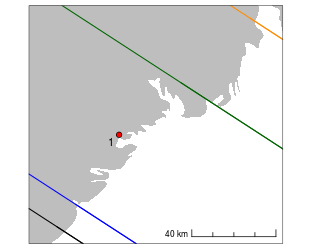
# The opactity of the geological displacement curves is reduced with
# displacement_alpha
displacement_plot(target_curve, displacement_alpha = 0.4)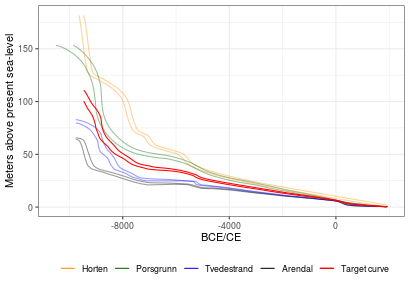
Shoreline dating
The following section outlines how to perform shoreline dating and ways in which to visualise the results. Various parameters and helper-functions underlying the dating procedure are also presented, along with ways to manipulate these if one wishes to explore the sensitivity of the dates or believe other parameters than the defaults are more sensible in a given setting.
Dating a single site
To perform a basic shoreline date, a site has to be provided as a
spatial sf object if the shoreline displacement is to be
interpolated to its location. In a addition to this, the elevation of
the site above the present sea-level has to be provided. This can either
be done by manually specifying the elevation, or by providing an
elevation raster (see below), in which case the elevation of the site
will be derived from the raster, provided the site is given as a spatial
object. In Roalkvam (2023) it was found that the vertical distance from
the sites to the contemporaneous shoreline within the study region could
be reasonably approximated by a gamma distribution. This forms the
foundation for the implementation of shoreline dating in the
package.
# Date the example point, manually specifying its elevation
target_date <- shoreline_date(target_point, elevation = 58.5)The results can then be plotted using the
shoredate_plot() command:
shoredate_plot(target_date)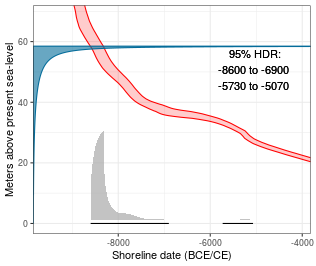
The blue gamma distribution on the y-axis indicates the likely
elevation of the site above sea-level when it was in use, which is
described by an empirically derived gamma distribution with the
parameters shape
()
= 0.286 and scale
()
= 20.833. These parameters can be adjusted by specifying the values
passed to model_parameters when calling
shoreline_date(). The red envelope is the shoreline
displacement curve as interpolated to the site location with
interpolate_curve(), which is run under the hood if a curve
is not provided to the target_curve argument of
shoreline_date().
Transferring the probability from the gamma distribution to the
calendar scale using the displacement curve gives the resulting
shoreline date in grey, which is underlined with the 95% highest density
region (HDR) in black. The coverage of the HDR can be adjusted with the
hdr_prob parameter. The dating procedure involves stepping
through the cumulative version of the gamma distribution, and at each
step subtracting the probability at the previous step from the current
one. The probability at each step is divided uniformly across the
calendar years in the range between the lower and upper limit of the
displacement curve. The default resolution on the calendar scale is 10
years, but this can be adjusted by specifying the cal_reso
argument. The gamma distribution is stepped through using increments of
0.01m, which can be adjusted by using the argument
elev_reso. By default, the resulting shoreline date is
normalised to sum to unity.
The function shoreline_date() returns an object of class
shoreline_date. By calling the object the dates are printed
to console, displaying site name, site elevation and the HDR of the
date. Furthermore, the first column of a data frame beyond the
geom column holding the sf geometry will be
used as site names. If no such column is present, the sites will simply
be numbered as they are passed to shoreline_date().
target_date## ===============
## Site: 1
## Elevation: 58.5
##
## 95% HDR:
## 8600 BCE-6900 BCE
## 5730 BCE-5070 BCEWhile a range of graphical parameters can be adjusted to change the
appearance of the output plot, setting greyscale = TRUE
offers a short-cut to plot a date in greyscale:
shoredate_plot(target_date, greyscale = TRUE)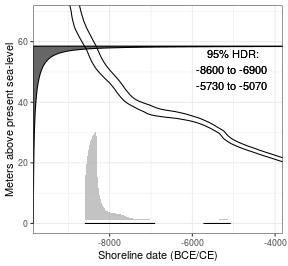
A more sparse version can also be plotted by specifying what elements are to be excluded from the plot:
shoredate_plot(target_date, elevation_distribution = FALSE,
displacement_curve = FALSE, highest_density_region = FALSE)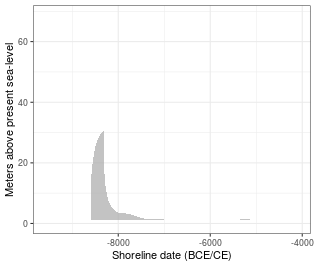
Finding the terminus post quem date
It is also possible to not account for the likely distance between
the site and the shoreline. This is done by setting the
model parameter to “none” when calling
shoreline_date(). This thus effectively provides a
termnius post quem date, the earliest possible date for when
the site could have been in use, under the assumption that when the sea
receded from the site location marks the earliest possible point in time
for the occupation of the site.
# Date the example point, manually specifying its elevation and setting the
# HDR coverage to 1.
tpq_date <- shoreline_date(target_point,
elevation = 58.5,
model = "none",
hdr_prob = 1)
# Plot and adjust the position of the HDR label on the y-axis
shoredate_plot(tpq_date, hdr_label_yadj = 0.6)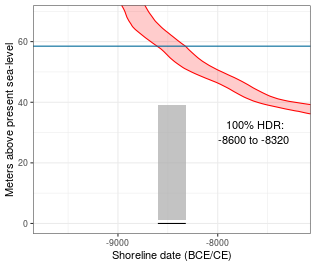
Dating multiple sites
As exemplified in the code chunks to follow, it is also possible to date multiple sites at once.
# Create multiple example points to be dated
target_points <- sf::st_sfc(sf::st_point(c(576052, 6567955)),
sf::st_point(c(554212, 6538835)),
sf::st_point(c(516599, 6512142)))
# Specify the correct CRS and make the points a sf data frame to be able to
# add the column below
target_points <- sf::st_as_sf(target_points, crs = 32632)
# Adding example site names
target_points$names <- c("Site 1", "Site 2", "Site 3")
# Create a plot showing the location of the points within the spatial limit
target_plot(target_points)
When dating multiple sites it can be useful to track the progress by
setting verbose = TRUE to print the progress to console
(this output is not reproduced here).
# Dating the target points, specifying the elevations in a
# vector of numeric values
target_dates <- shoreline_date(target_points,
elevation = c(68, 98, 73),
verbose = TRUE)
# Print results
target_dates## ===============
## Site: Site 1
## Elevation: 68
##
## 95% HDR:
## 7630 BCE-6110 BCE
## 6000 BCE-5430 BCE
## ===============
## Site: Site 2
## Elevation: 98
##
## 95% HDR:
## 9020 BCE-8470 BCE
## ===============
## Site: Site 3
## Elevation: 73
##
## 95% HDR:
## 9170 BCE-8340 BCEThe default behaviour when passing multiple dates to
shoredate_plot() is to plot a series of individual plots.
However, setting multiplot = TRUE collapses the dates on a
single, more sparse plot. The sites are ordered from from earliest to
latest possible start date for the occupation of the sites.
shoredate_plot(target_dates, multiplot = TRUE)
Using an elevation raster to find site elevations
The below code demonstrates how to find the elevation of one or more
sites by passing a digital elevation model (DEM) to
shoreline_date(). The example here uses data from Amazon
Web Service Terrain Tiles, retrieved with the package
elevatr. However, the best elevation data available for the
study area can be retrieved freely from the Norwegian Mapping Authority
at https://hoydedata.no/LaserInnsyn2/. To use this with
shoredate, manually download a raster covering the location of
the sites to be dated and read this in to R with
terra::rast() before passing it to
shoreline_date().
# Reproject target_point for retrieving raster data with elevatr
target_wgs84 <- sf::st_transform(target_point, crs = 4326)
# Retrieve raster data
elev_raster <- elevatr::get_elev_raster(target_wgs84, z = 14, src = "aws")
# Make the retrieved raster a SpatRaster and re-project
# it to the correct coordinate system
elev_raster <- terra::project(terra::rast(elev_raster), "epsg:32632")
# Plot the raster and target point for inspection
terra::plot(elev_raster)
plot(target_point, add = TRUE)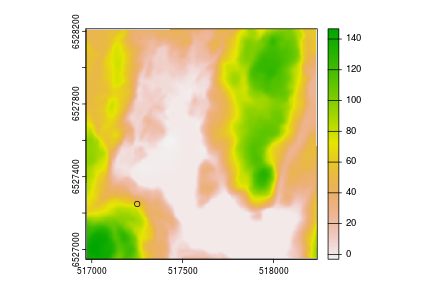
When a SpatRaster has been loaded into the R session
this can be passed to shoreline_date() by specifying it in
the elevation argument. This is then used to find the site
elevations without having to provide these manually, as was done above.
Note that if a site is represented by an object with a spatial extent
(i.e. not a point feature) the default is to use the mean of the
elevation on the raster. This can be changed with the
elev_fun argument which accepts any function that can be
passed to the fun argument in terra::extract()
(see ?terra::extract).
raster_date <- shoreline_date(target_point, elevation = elev_raster)
# Print to console
raster_date## ===============
## Site: 1
## Elevation: 58.47393
##
## 95% HDR:
## 8600 BCE-6890 BCE
## 5730 BCE-5070 BCESummed probability distribution of shoreline dates
Using sum_shoredates() it is also possible to sum the
probability of multiple shoreline dates to evaluate the temporal
intensity of the dates, as is frequently done with calibrated
radiocarbon dates (e.g. Crema and Bevan 2021). Do note that as this
procedure involves collapsing the frequency of dates and their
uncertainty, the interpretation of the resulting sum is not
straightforward (see Roalkvam and Solheim 2025 for a study that explores
this issue in the context of shoreline dates).
# Sum the three dates from above
summed_dates <- sum_shoredates(target_dates)A simple line plot displaying the resulting summed probability can
then be produced with shoredate_sumplot().
shoredate_sumplot(summed_dates)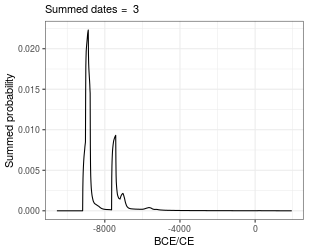
Direction of shoreline gradient
The direction of the shoreline gradient is specified by the isobases that run perpendicular to this gradient. When interpolating the displacement curve used for dating a site, the direction of these isobases defaults to 327, following Romundset et al. (2018:180, fig.1). However, some authors operate with different isobase directions, with Sørensen et al. (2014:fig.2.2.3) using 338. Furthermore, the direction of the uplift gradient might have varied throughout the Holocene (Sørensen et al. 2014:42–44).
Specifying different isobase directions
While the range of the typically employed isobase directions generally result in minor differences in the resulting shoreline dates, it is possible to specify other and multiple directions for these, and perform the shoreline dating using each individual direction. This can be useful either for evaluating the sensitivity of a date or if one believes there is reason suspect a different direction than the default in a particular case.
# Add a name to the example site
target_point <- sf::st_as_sf(target_point, crs = 32632)
target_point$name <- "Example site"
# Using the same target point and elevation as above, but specifying two
# different directions for the isobases when dating
iso_date <- shoreline_date(site = target_point, elevation = elev_raster,
isobase_direction = c(325, 338))
iso_date## ===============
## Site: Example site
## Elevation: 58.47393
##
## Isobase direction: 325
##
## 95% HDR:
## 8610 BCE-6900 BCE
## 5710 BCE-5070 BCE
##
## Isobase direction: 338
##
## 95% HDR:
## 8560 BCE-6900 BCE
## 5810 BCE-5070 BCEIn the call to plot it can then be specified that the direction of
the isobases is printed with each date. Note that it is not possible use
multiplot when having used multiple isobase directions when
dating the sites. The following thus also shows the default behaviour
when plotting multiple dates at once and not setting
multiplot = TRUE.
shoredate_plot(iso_date,
site_name = TRUE,
isobase_direction = TRUE,
hdr_label_yadj = 0.35)
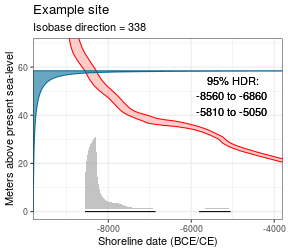
Sum the probability of dates across isobase directions
As an alternative to keeping the two shoreline dates of the site
separate, the parameter sum_isobase_directions can be set
to TRUE when calling shoreline_date() to sum
the probability of the dates. Again, by default this is normalised to
sum to unity.
sum_iso_date <- shoreline_date(site = target_point,
elevation = elev_raster,
isobase_direction = c(325, 338),
sum_isobase_directions = TRUE)
sum_iso_date## ===============
## Site: Example site
## Elevation: 58.47393
##
## Sum of isobase directions: 325 338
##
## 95% HDR:
## 8610 BCE-6880 BCE
## 5770 BCE-5060 BCEThis can then be passed to shoredate_plot(). Note that
the interpolated displacement curves and the gamma distribution for the
elevation of the site above sea-level is not included in the plot when
summing the probability of dates across isobase directions.
shoredate_plot(sum_iso_date, site_name = TRUE, isobase_direction = TRUE)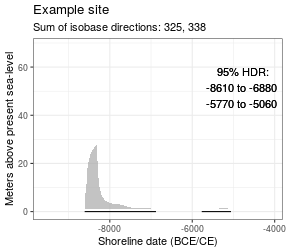
References
Brøgger, W.C. 1905 Strandliniens beliggenhed under stenalderen i det sydøstlige Norge. Geological Survey of Norway, Kristiania. URI: https://hdl.handle.net/11250/2675184
Crema, E. and Bevan, A. 2021. Inference from Large Sets of Radiocarbon Dates: Software and Methods. Radiocarbon 61(1):23–39. DOI: 10.1017/RDC.2020.95
Glørstad, H. 2016. Deglaciation, sea-level change and the Holocene colonization of Norway. Geological Society, London, Special Publications 411(1):9–25. DOI: 10.1144/SP411.7
Roalkvam, I. 2023 A simulation-based assessment of the relation between Stone Age sites and relative sea-level change along the Norwegian Skagerrak coast. Quaternary Science Reviews 299:107880. DOI: 10.1016/j.quascirev.2022.107880
Roalkvam, I. and Solheim, S. 2025 Comparing Summed Probability Distributions of Shoreline and Radiocarbon Dates from the Mesolithic Skagerrak Coast of Norway. Journal of Archaeological Method and Theory 32(1):26. DOI: 10.1007/s10816-025-09696-7
Romundset, A. 2018. Postglacial shoreline displacement in the Tvedestrand–Arendal area. In The Stone Age Coastal Settlement in Aust-Agder, Southeast Norway, edited by Reitan, G. and Sundström, L.. Cappelen Damm Akademisk, Oslo, pp. 463–478. DOI: 10.23865/noasp.50
Romundset, A. 2021. Resultater fra NGUs undersøkelse av etteristidas strandforskyvning nord i Vestfold. Geological Survey of Norway, Trondheim.
Romundset, A., Lakeman, T.R. and Høgaas, F. 2018. Quantifying variable rates of postglacial relative sea level fall from a cluster of 24 isolation basins in southern Norway. Quaternary Science Reviews 197:175e192. DOI: 10.1016/ j.quascirev.2018.07.041
Sørensen, R, Henningsmoen, K.E. Høeg, H.I. and Gälman V. 2023. Holocen vegetasjonshistorie og landhevning i søndre Vestfold og sørøstre Telemark. In The Stone Age in Telemark. Archaeological Results and Scientific Analysis from Vestfoldbaneprosjektet and E18 Rugtvedt–Dørdal, edited by Persson, P. and Solheim, S., in press.
Sørensen, R, Henningsmoen, K.E. Høeg, H.I. and Gälman V. 2014. Holocene landhevningsstudier i søndre Vestfold og sørøstre Telemark – Revidert kurve. In Vestfoldbaneprosjektet. Arkeologiske undersøkelser i forbindelse med ny jernbane mellom Larvik og Porsgrunn. Bind 1, edited by Melvold, S. and Persson, P. Portal forlag, Kristiansand, pp. 36–47. DOI: 10.23865/noasp.61